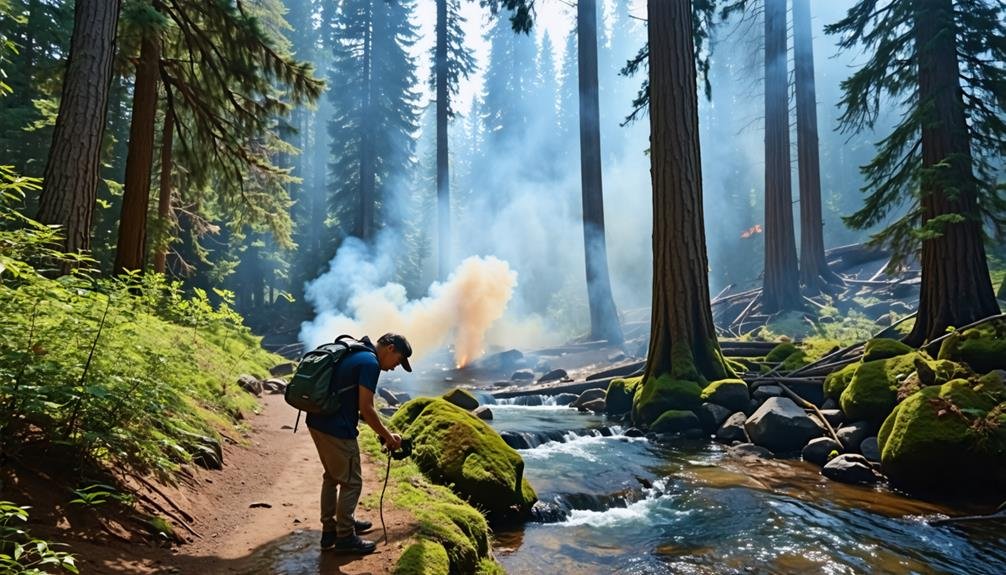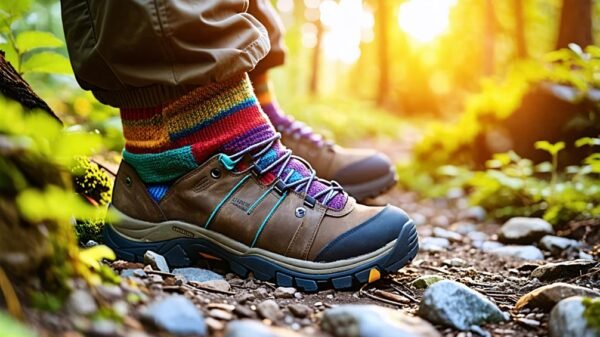If you encounter wildfire smoke while hiking, prioritize your safety by retreating to cleaner air. Monitor air quality using resources like InciWeb and AirNow.gov before heading out. If smoke becomes thick, wear an N95 respirator mask to filter harmful particles and stay hydrated. Recognize symptoms such as coughing or eye irritation, and avoid strenuous activities. Familiarize yourself with alternative routes and places to take shelter if conditions worsen. Always inform someone about your hike. After your excursion, shower and change clothes to remove smoke residues. There's more helpful information on staying safe during such situations ahead.
Check for Active Wildfires
Before embarking on your hiking adventure, it is essential to check the InciWeb platform for any active wildfires in your vicinity. This step ensures your safety and helps you make informed decisions regarding your hiking route. Wildfire smoke can significantly deteriorate outdoor air quality, which might pose health hazards during your trek. By monitoring InciWeb, you gain access to real-time updates on wildfires, allowing you to steer clear of areas with hazardous smoke levels and ongoing fire activity.
Being aware of the potential risks associated with hiking in smoky conditions includes recognizing how smoke can irritate your respiratory system and impact your ability to breathe easily. If you observe a decline in air quality, it may be prudent to adjust your plans or postpone your hike until conditions improve. Prioritizing hiking safety is crucial; being proactive can enable you to enjoy the beauty of nature without unnecessary risks.
In addition to checking for active wildfires on InciWeb, consider consulting other sources like local news outlets or community alerts. This approach helps you stay informed about any developments that could influence your hiking experience. With thoughtful planning and awareness, you can fully enjoy the great outdoors while safeguarding your health and safety.
Monitor Air Quality Before Hiking
Before heading out on a hike, it's crucial to monitor air quality to guarantee a safe experience. Checking resources like InciWeb for active wildfires and using AirNow.gov can provide critical information about smoke levels in the area. Staying informed not only protects your health but also enriches your enjoyment of the great outdoors, allowing you to make informed decisions about your hiking plans.
Check InciWeb Updates
Monitoring InciWeb updates is crucial for outdoor enthusiasts to stay informed about ongoing wildfires and make wise choices regarding trail safety and air quality. This platform offers real-time data about wildfires across the United States, allowing hikers to evaluate risks before embarking on their journey. Utilizing this tool is a vital hiking tip for ensuring a safe and enjoyable adventure.
Here are three important factors to consider when reviewing InciWeb updates:
- Wildfire Locations: Determine any active wildfires close to your planned hiking path. Knowing the distance can help you steer clear of hazardous areas.
- Fire Dynamics: Keep up with information on how the fire is advancing and its potential effects on regional air quality. This insight is essential for your well-being.
- Trail Restrictions: Look for any closures or limitations on trails due to fire activity. Being aware of these changes can prevent unexpected detours.
Use AirNow.gov Resources
Using AirNow.gov is vital for assessing air quality before a hike, particularly in areas susceptible to wildfire smoke. This straightforward platform provides real-time air quality information across the United States. By entering your specific location, you can obtain crucial details about particulate matter levels, which can surge during wildfire incidents.
When checking AirNow.gov, focus on the Air Quality Index (AQI) ratings. These ratings, which range from good to hazardous, clearly indicate whether hiking is safe. If the AQI falls within the unhealthy category, think about delaying your hike or opting for a different site with cleaner air.
Furthermore, AirNow.gov provides useful safety tips for smoke events, like wearing N95 respirators or taking regular breaks in areas with fresh air. Always prioritize your health and safety. By utilizing AirNow.gov, you can make well-informed choices that enable you to enjoy outdoor adventures while safeguarding your well-being. Embrace the journey, but remain conscious of the air quality around you.
Essential Gear to Pack

Packing the right gear is vital for safety and readiness when hiking in areas affected by wildfire smoke. Being well-equipped enhances your experience and safeguards your health.
Here are three essential items to include:
- 3M N95 Respirator Mask: This respirator filters out dangerous particles from the air, improving your breathing during smoky conditions. It's particularly important when air quality is compromised, as it minimizes smoke inhalation.
- Airthings Portable Air Quality Monitor: This device tracks real-time air quality levels during your hike. By staying informed about changing conditions, you can make smart choices regarding your path and the time you spend outdoors.
- CamelBak Hydration System: Staying hydrated is crucial in demanding environments. A CamelBak hydration pack or reliable water bottles will provide ample hydration, which is essential for maintaining your energy and overall health.
Safety Measures on the Trail
Understanding the terrain and potential dangers is crucial for ensuring safety while hiking in regions susceptible to wildfire smoke. Before embarking on your journey, it's prudent to verify active wildfires and check air quality using platforms like InciWeb and AirNow.gov. As you begin your hike, sign the visitor log at the trailhead and familiarize yourself with alternative routes and exit paths. Identifying safe spots, such as ponds or meadows, can provide shelter if conditions deteriorate.
Stay vigilant to changes in your surroundings. If the sky's hue alters or the smoke thickens, be ready to modify your path swiftly. Recognize significant landmarks to assist in navigating back to safety, favoring areas with reduced foliage. Always keep your emergency supplies handy, including a headlamp and a Garmin satellite communicator for emergencies.
Recognizing Smoke Hazards

Recognizing smoke hazards while hiking is essential for your safety and well-being. You can identify smoke by paying attention to distinct odors, such as a strong burning smell, and by observing visual signs like hazy air or a dimmed sky. Furthermore, be aware of health symptoms, such as coughing or shortness of breath, which can indicate harmful smoke exposure and should prompt immediate action.
Identifying Smoke Odors
The presence of smoke odors during a hike can signal nearby wildfire hazards, requiring immediate caution and environmental assessment. Recognizing these scents aids in making informed safety decisions. Smoke odors typically have a strong, acrid scent that varies based on the materials burned, but always indicates a potential risk.
To effectively detect smoke odors, consider the following:
- Scent Intensity: A more potent smell usually means proximity to the fire source. If the odor becomes overpowering, altering your route or exiting the area is advisable.
- Smoke Type: Different materials yield unique odors. For instance, burning pine trees emit a sweet, earthy aroma, while plastics like PVC can release a sharp, chemical-like scent.
- Odor Consistency: An intermittent smell may indicate a fire that is not stationary. Remain alert and be ready to adjust your plans based on any changes in the scent.
Visual Signs of Smoke
Visual indicators of smoke, such as a hazy atmosphere, dark clouds, or a visible plume, serve as crucial warnings of nearby wildfire activity, necessitating immediate assessment and action. While hiking, be mindful of your surroundings. If the sky appears unusually gray or orange, or if you notice swirling smoke rising from the horizon, this may signal a wildfire nearby. These visual cues can change rapidly, so staying alert is key.
Additionally, observe signs like increased bird activity or the absence of wildlife, as animals often flee from smoke. If you see flickering light or glowing embers, consider leaving your hiking path immediately.
While these signs can be alarming, understanding them allows for proactive steps. Always prioritize safety by knowing escape routes and having a plan in place. If you spot any visual signs, trust your instincts and assess the situation calmly. Recognizing these hazards is crucial for ensuring a safe and enjoyable hiking experience, even in the face of potential wildfire threats.
Health Symptoms to Watch
Awareness of health symptoms linked to smoke exposure is crucial for hikers to ensure their safety during outdoor adventures. Wildfire smoke can impact everyone, particularly individuals with respiratory conditions. Identifying these symptoms promptly can enable you to take necessary measures.
Here are three important health indicators to monitor:
- Breathing Issues: If you face coughing, wheezing, or difficulty breathing, it could suggest you are inhaling harmful smoke particles. These issues may escalate with physical activity.
- Ocular Discomfort: Smoke can lead to red, itchy, or watery eyes. If you experience eye discomfort, it may be time to find shelter from the smoke.
- Migraines and Exhaustion: Ongoing headaches or unusual fatigue can indicate smoke inhalation. Stay attuned to how your body reacts during your trek.
If you observe any of these symptoms, prioritize your health. Seek fresh air, consider retracing your steps, or locate an area with clearer air. Remember, your safety and well-being are essential as you explore the beauty of the outdoors.
Immediate Actions During Smoke
Upon detecting wildfire smoke while hiking, take immediate action to ensure safety and reduce health risks. First, assess your environment. If the smoke is dense or the air quality is poor, it is vital to retreat from the area. Move to lower altitudes or locations with less vegetation, such as clearings or near bodies of water, where smoke concentration is lower.
Next, safeguard your respiratory health. If you have an N95 respirator, wear it to filter harmful particulates. If a respirator is unavailable, cover your mouth and nose with a cloth. Stay hydrated, as drinking water can relieve some respiratory discomfort associated with smoke inhalation.
Monitor your physical condition closely. If you experience symptoms like coughing, wheezing, or difficulty breathing, find a safe spot to rest and recuperate. Avoid strenuous activities, as they can exacerbate the effects of smoke inhalation.
Evacuation Routes and Navigation

During a wildfire emergency, hikers can enhance their safety by effectively navigating evacuation routes. Understanding the terrain and having a solid plan is essential. Before embarking on a hike, it's vital to familiarize oneself with the specific area. Knowing the quickest escape routes can be crucial when smoke descends or visibility diminishes.
Here are three essential strategies for identifying evacuation paths:
- Examine the Trail Map: Prior to your hike, carefully study the trail map to identify potential evacuation routes and significant landmarks. This knowledge can help maintain composure and focus during an emergency.
- Utilize Natural Landmarks: Rely on prominent natural features, such as rivers or mountains, to guide your way. In stressful situations, recognizable points of reference can provide both reassurance and direction.
- Know Alternate Routes: Always prepare a contingency plan. Be aware of various paths to exit the area, particularly if the primary route becomes hazardous.
Signaling for Help
When hiking in areas affected by wildfire smoke, knowing how to signal for help is essential for your safety. Emergency communication devices, like satellite phones or personal locator guides, can provide a direct line to rescuers when visibility is low. Moreover, employing visual signaling techniques, such as using a signal mirror or creating large, noticeable symbols on the ground, can help attract attention and facilitate a quicker response.
Emergency Communication Devices
Emergency communication tools, like Garmin inReach satellite communicators and ACR ResQLink personal locator beacons, are crucial for maintaining safety during outdoor expeditions, especially in remote or perilous areas. These gadgets allow trekkers to maintain connectivity and signal for assistance when faced with emergencies like wildfire smoke.
Here are three indispensable emergency communication tools to consider:
- Garmin inReach Satellite Communicators: These portable devices enable two-way messaging even in regions lacking cellular coverage. They can dispatch SOS signals to emergency responders, facilitating swift assistance.
- ACR ResQLink Personal Locator Beacons (PLBs): PLBs are compact gadgets that transmit distress signals to search and rescue units. Activating an ACR ResQLink can be a lifesaver in critical situations, as it relays your coordinates via satellite.
- Midland Weather Alert Radios: These radios provide real-time updates on changing weather patterns and wildfire warnings. Staying informed allows for timely adjustments to your route and enhances safety.
Equipping yourself with these devices can amplify your sense of adventure while hiking. Knowing you can request help fosters confidence in exploring challenging terrains. Always verify that your devices are charged and operational before embarking on your journey.
Visual Signaling Techniques
Effective visual signaling methods are crucial for hikers needing help in wilderness scenarios, especially when conventional communication tools fail. When in distress, using vivid colors and reflective gear enhances visibility. For example, waving a neon jacket or a bright backpack can capture the attention of search teams.
Another useful technique involves arranging large symbols on the ground with stones, branches, or other natural items. Crafting a sizable 'SOS' or an arrow leading to your position can guide rescuers to you. If feasible, employing a signal mirror from brands like Coghlan's can reflect sunlight and transmit a distinct message across distances.
At night, utilizing a flashlight allows you to create a signaling pattern, such as three short flashes followed by three long flashes, indicating a call for assistance. Always strive to maintain a clear signaling area, ensuring your visual cues are prominent.
In emergencies, staying composed and using these visual strategies can greatly enhance your likelihood of being found. Equipping yourself with these techniques provides reassurance, allowing you to fully embrace the wonders of the outdoors with confidence.
Post-Hike Hygiene and Health

After hiking in areas affected by wildfire smoke, proper hygiene and health monitoring are essential to minimize health risks from smoke inhalation. Here are three vital actions to consider:
- Take a Shower and Change Attire: Smoke residues can settle on your skin and gear. A comprehensive shower followed by donning fresh garments will eliminate these harmful residues and alleviate skin irritation.
- Observe Your Health: Stay alert for any symptoms, including coughing, difficulty breathing, or headaches. These could indicate smoke exposure. Maintaining a health journal can help track any changes.
- Consult a Medical Professional if Necessary: If symptoms persist or worsen, seek advice from a healthcare provider. They can offer recommendations and treatments to protect your health.
Long-Term Smoke Exposure Risks
Prolonged exposure to wildfire smoke presents significant health hazards, including respiratory issues and cardiovascular complications. Fine particulate matter found in smoke can infiltrate deep into the lungs, resulting in chronic conditions such as asthma or bronchitis. Individuals with existing health problems, like coronary artery disease, are particularly at risk and may see their symptoms worsen.
Additionally, research indicates that long-term exposure to smoke can heighten the likelihood of heart attacks and strokes. This is attributed to the impact smoke has on blood vessels and cardiovascular health. Outdoor enthusiasts and residents in regions susceptible to wildfires should be acutely aware of these dangers. Keeping track of air quality through trusted resources can aid in making informed choices about outdoor activities during smoke events.
To safeguard your health, it's essential to minimize exposure on days with high smoke levels. Utilizing an N95 respirator mask and staying indoors when air quality declines can significantly lower health risks. If you experience ongoing symptoms such as cough, difficulty breathing, or chest discomfort, seek advice from a healthcare provider. By understanding these health risks, you can enjoy your outdoor pursuits while placing a premium on your health and wellness.

































